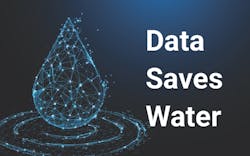About the author:
Henrique Costa is director of business development for Itron. Costa can be reached at [email protected].
The world is enduring a water crisis at the hands of rising demand, prevalent leaks, reduction in supply and an uptick in droughts, and businesses, municipalities and individuals are feeling the pressure to use water resources more responsibly.
The New York Times reported the average water pipeline in the U.S. will be 45 years old by 2020, and some pipelines have been in the ground for up to 150 years. Beyond leaking, corrosion and lead contamination are just a few risks and challenges with which agencies and utilities must contend, or they will risk sacrificing significant time and money to rebuild, repair or renovate these aging infrastructure systems.
Even more concerning, a 2014 study involving seven western states—Arizona, Colorado, Utah, Wyoming, California, New Mexico and Nevada—found underground water loss due to droughts was responsible for three-quarters of cumulative water loss over a 14-year period starting in 2000.
In efforts to combat water loss amid drought, it becomes more critical for everyone—individuals, businesses and municipalities—to have an accurate, real-time understanding of water usage and demand. That information can be powered by data.
Tracking Leaks
When it comes to tracking leaks, granular data is the key to understanding where leaks come from and how to stop them. No data is more granular than interval data. This term refers to partitioning meter register consumption into specific timeslots. In a utility’s service territory, interval data from residential, commercial and industrial meters—either separately or aggregately—provides visibility into every drop of water delivered and every drop of water lost, whether it was a result of old and weakened infrastructure or theft.
Using acoustic leak sensing technology, a utility quickly can pinpoint the location where potential water losses exist.
The same interval data can identify leaks resulting in unnecessary waste or unneeded consumption. With access to hourly interval data, utilities can better understand how much water is consumed, in addition to when and where leaks exist.
Understanding Water Usage With Interval Data
Interval data works in tandem with advanced metering infrastructure (AMI) deployed by utilities to detect, predict and prevent water losses. AMI integrates smart metering systems, communications networks and data management systems with two-way communication between utilities and customers. This technology encompasses the full measurement and collection system, including meters at the customer site, communication networks between the customer and a service provider, and data reception and management systems to make the information available to the water provider.
AMI makes it possible to collect large quantities of data associated with managing meters and measuring customer consumption, allowing utilities to monitor the integrity of distribution systems and track consumer compliance with conservation initiatives. Once again, data plays a role to create awareness, and from awareness comes action. These actions can impact how a utility services its customers, how those customers consume water and how that water can be sustained.
Quick Response to Non-Revenue & Unsafe Water
Real-time data is critical in guaranteeing the safety of drinking water and protecting the public from health hazards, such as waterborne pathogens.
Between 2013 and 2014, 42 outbreaks of drinking water poisonings in the U.S. were recorded by the U.S. Centers for Disease Control and Prevention (CDC). Reports have not subsided. The only valid response is immediate action, and sensor data from a water treatment system enables immediate insights for action before individuals can
be harmed.
Preventive measures, such as installing whole-home filtering systems or under-sink water purification systems, can assist with purification efforts. Utilities also comply with the Safe Drinking Water Act, which requires them to notify the public about any detected regulated contaminant in their water and any water quality violation. To detect pollutants, water quality sensors that leverage a utility’s AMI network are beneficial.
Water utilities have the ongoing challenge of innovating services and delivering fresh water to their customers. The industry has seen speedy innovation with AMI and sensor integrations, and now is the time to harness the value of interval data to not only chart delivery and conservation, but also to help address the next generation of water scarcity and safety challenges.
